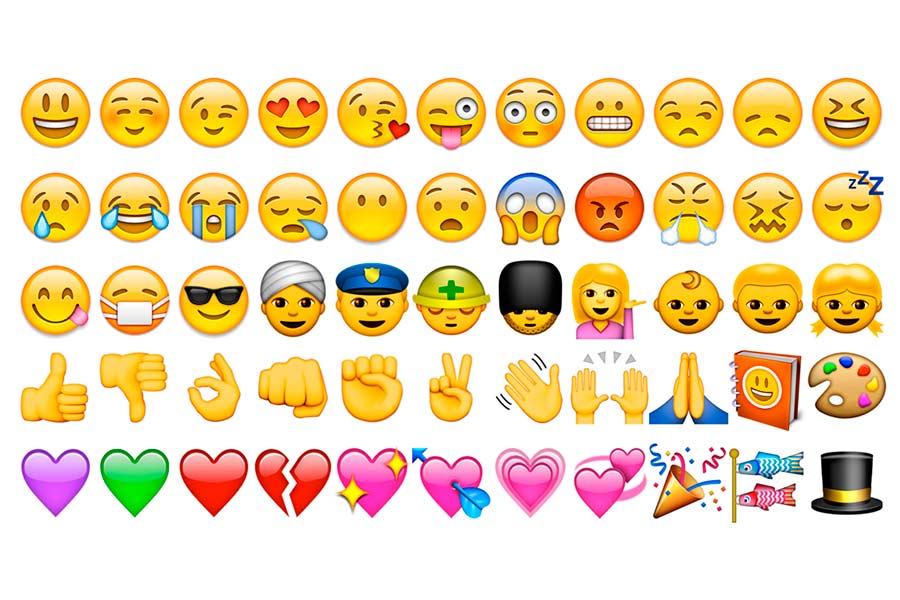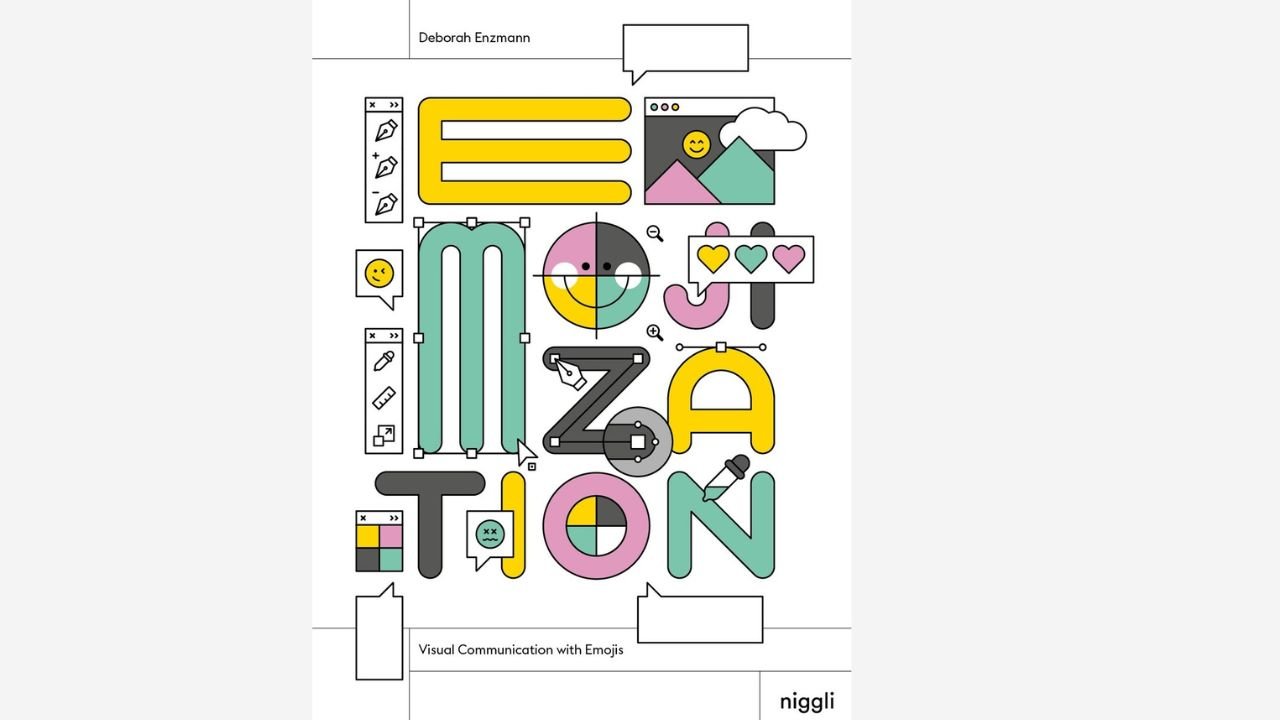In an age where a simple smiley face or a thumbs-up can transcend language barriers and instantly communicate emotions (albeit occasionally ambiguously!) emojis have become an integral part of our modern lexicon. But how did these tiny pictorial symbols evolve from quirky digital additions to a powerful cultural phenomenon? Emojization by Deborah Enzmann offers an exploration of the creative potential, cultural significance, and theoretical background of emojis.

Packed with vibrant visuals, practical examples, and even a set of kawaii stickers, this book isn’t just a design manual; it’s a love letter to one of the most universal forms of communication. From their role in shaping visual identities to their dynamic interpretations across cultural and social contexts, Emojization dives deep into the emoji universe.
In this Q&A, Enzmann shares her inspiration behind the book, her thoughts on the evolving significance of emojis, and her favourite creative examples of their use in design and technology.

1. What inspired you to write Emojization, and what key insights do you hope readers will take away from it?
As a designer, I am interested in emojis because they have developed into a global tool for communication. The theme of the book emerged from my dissertation project, and the idea for the new book was shaped through exchanges with Markus Sebastian Braun, the publisher at Niggli. The aim was to make the topics of the dissertation accessible to a broader target audience by presenting the content more visually and clarifying the scientific findings using numerous practical examples. The result is a book for designers that explores the possibilities of using emojis in visual communication.
With this book, I aim to show the many ways emojis can be used in design projects and how they can become an integral part of a visual identity. I hope the book will open up a different perspective on the emergence and potential of emojis. Because emojis are more than just small, colorful signs that decorate our messages.
2. Emojis have become an integral part of modern communication. In your view, what is their cultural significance, and how do they shape the way we express ourselves today?
I find the topic particularly relevant for designers, as the rise of emojis has created a new way of integrating pictorial signs into our communication. These characters not only influence how we communicate but also shape our perception of such and similar signs. In Japan, for instance, cute characters have a completely different significance – they are an integral part of everyday life. I find this fascinating and am convinced that the use of emojis will continue to influence our perception and the design of future signs. For this reason, I believe it is important for me as a designer to engage with such developments.
3. Given that emojis often evolve in meaning based on cultural and social contexts, how do you envision their interpretations and uses changing in the future?
The meaning and use of emojis have so far been strongly influenced by technical developments. For example, the number of available emojis, their appearance, and the ways in which they can be used are heavily dependent on technological possibilities. At the same time – often due to technical limitations – users are continuously ascribing new meanings or layers of meaning to emojis, which expands their range of applications. I find the context-sensitive and multifunctional nature of emojis particularly exciting, as it makes them a flexible and personalized tool for communication.
I believe that technical developments will continue to have a significant impact on the use of emojis in the future. The cultural and social backgrounds of users also play a central role, as they determine how emojis are interpreted and utilized. As a result, emojis will remain a dynamic form of communication that constantly evolves.

4. What’s your favourite example of emojis being used creatively in design or technology?
I find the Waze project by the design studio Pentagram New York, created under the direction of Natasha Jen, particularly exciting because it combines a classic navigation app with social networking functions through the use of emojis. The designers introduced a series of emojis that enable users to share their driving experiences. The goal is to leverage social networking to solve traffic problems in both a fun and functional way. As is characteristic of Pentagram, all communication elements are structured within a thoughtful design grid, and the emojis reflect Waze’s visual identity. Pentagram harnesses the potential of emojis in two ways: first, through their design, they become an integral part of the visual identity, and second, they play a key role in problem-solving within the app.
Emojization by Deborah Enzmann will be published on February 3 2025






Hey very cool website!! Man .. Beautiful .. Amazing .. I’ll bookmark your site and take the feeds also…I am happy to find a lot of useful info here in the post, we need work out more strategies in this regard, thanks for sharing. . . . . .
PrimeBiome is a premium probiotic formula that focuses on restoring the natural balance of good bacteria in the gut. By doing so, it helps reduce digestive discomfort, supports immune function, and boosts nutrient absorption.
Very informative and fantastic bodily structure of subject matter, now that’s user genial (:.
Mitolyn is a premium dietary supplement that focuses on mitochondrial support, helping your cells produce energy more efficiently.
I think this internet site has some real fantastic info for everyone. “A man’s dreams are an index to his greatness.” by Zadok Rabinwitz.
Great ?V I should definitely pronounce, impressed with your site. I had no trouble navigating through all the tabs as well as related information ended up being truly easy to do to access. I recently found what I hoped for before you know it at all. Reasonably unusual. Is likely to appreciate it for those who add forums or anything, site theme . a tones way for your client to communicate. Excellent task..
Hello There. I found your blog using msn. This is an extremely well written article. I will be sure to bookmark it and return to read more of your useful information. Thanks for the post. I’ll definitely comeback.
LottoChamp is a lottery prediction software that uses statistical analysis and mathematical algorithms to help users choose more strategic numbers when playing the lottery.
I like what you guys are up also. Such intelligent work and reporting! Carry on the superb works guys I’ve incorporated you guys to my blogroll. I think it will improve the value of my web site :).
I really enjoy studying on this website, it contains excellent blog posts. “The living is a species of the dead and not a very attractive one.” by Friedrich Wilhelm Nietzsche.
I truly enjoy examining on this web site, it has got fantastic blog posts.
Spot on with this write-up, I really suppose this web site needs rather more consideration. I’ll probably be again to read much more, thanks for that info.
Currently it appears like Movable Type is the best blogging platform out there right now. (from what I’ve read) Is that what you’re using on your blog?
Wonderful work! This is the type of info that should be shared around the web. Shame on the search engines for not positioning this post higher! Come on over and visit my website . Thanks =)
Appreciate it for helping out, superb info .
The Pink Salt Trick is a minimalist but effective morning routine: Just drink a glass of lukewarm water mixed with a pinch of Himalayan pink salt as soon as you wake up.
I was recommended this website by my cousin. I am not sure whether this post is written by him as no one else know such detailed about my trouble. You are amazing! Thanks!
I don’t even know how I ended up here, but I thought this post was good. I don’t know who you are but definitely you are going to a famous blogger if you are not already 😉 Cheers!
Its superb as your other posts : D, thanks for posting.
F*ckin’ amazing issues here. I am very satisfied to see your post. Thanks a lot and i am looking ahead to contact you. Will you please drop me a mail?
The Pink Salt Trick is a minimalist but effective morning routine: Just drink a glass of lukewarm water mixed with a pinch of Himalayan pink salt as soon as you wake up.
What’s Happening i am new to this, I stumbled upon this I have found It positively useful and it has aided me out loads. I hope to contribute & aid other users like its helped me. Great job.
Keep working ,splendid job!
The subsequent time I learn a weblog, I hope that it doesnt disappoint me as much as this one. I mean, I do know it was my choice to read, however I really thought youd have one thing fascinating to say. All I hear is a bunch of whining about something that you would fix in case you werent too busy searching for attention.
We are a group of volunteers and opening a new scheme in our community. Your website provided us with valuable information to work on. You’ve done a formidable job and our whole community will be thankful to you.
Wonderful work! This is the type of information that should be shared around the net. Shame on the search engines for not positioning this post higher! Come on over and visit my web site . Thanks =)
What¦s Going down i am new to this, I stumbled upon this I’ve found It absolutely useful and it has aided me out loads. I hope to give a contribution & aid different users like its aided me. Good job.
Wonderful beat ! I would like to apprentice while you amend your website, how could i subscribe for a blog website? The account helped me a acceptable deal. I had been tiny bit acquainted of this your broadcast offered bright clear idea
Hello, Neat post. There’s a problem with your website in internet explorer, may check thisK IE still is the marketplace leader and a good part of other people will miss your great writing because of this problem.
Great post, I conceive people should larn a lot from this web blog its rattling user pleasant.
You can certainly see your expertise within the paintings you write. The sector hopes for even more passionate writers such as you who are not afraid to mention how they believe. Always follow your heart. “We may pass violets looking for roses. We may pass contentment looking for victory.” by Bern Williams.
Its wonderful as your other articles : D, appreciate it for putting up.
Thank you for the auspicious writeup. It in fact was a amusement account it. Look advanced to more added agreeable from you! However, how can we communicate?
Enjoyed examining this, very good stuff, appreciate it.
I’m not sure why but this blog is loading very slow for me. Is anyone else having this issue or is it a problem on my end? I’ll check back later on and see if the problem still exists.
Rattling clean web site, appreciate it for this post.
Very interesting details you have remarked, regards for putting up.
I’m very happy to read this. This is the type of manual that needs to be given and not the accidental misinformation that’s at the other blogs. Appreciate your sharing this greatest doc.
Hi there! Would you mind if I share your blog with my twitter group? There’s a lot of people that I think would really enjoy your content. Please let me know. Thank you
Hi there, i read your blog from time to time and i own a similar one and i was just wondering if you get a lot of spam feedback? If so how do you protect against it, any plugin or anything you can suggest? I get so much lately it’s driving me insane so any assistance is very much appreciated.
I’m truly enjoying the design and layout of your website. It’s a very easy on the eyes which makes it much more enjoyable for me to come here and visit more often. Did you hire out a designer to create your theme? Fantastic work!
Hi my friend! I wish to say that this article is awesome, great written and include approximately all important infos. I would like to look extra posts like this.
I was curious if you ever considered changing the structure of your blog? Its very well written; I love what youve got to say. But maybe you could a little more in the way of content so people could connect with it better. Youve got an awful lot of text for only having 1 or 2 pictures. Maybe you could space it out better?
whoah this blog is fantastic i love studying your articles. Stay up the great paintings! You understand, lots of individuals are hunting round for this info, you could help them greatly.
Way cool, some valid points! I appreciate you making this article available, the rest of the site is also high quality. Have a fun.
I together with my guys were found to be looking through the good procedures located on your site and quickly came up with an awful feeling I had not thanked you for those tips. Those guys ended up consequently joyful to learn all of them and have now truly been tapping into them. I appreciate you for genuinely considerably considerate as well as for settling on these kinds of important useful guides millions of individuals are really needing to understand about. Our sincere regret for not saying thanks to earlier.
Hello very nice web site!! Guy .. Excellent .. Amazing .. I’ll bookmark your website and take the feeds also?KI am glad to find a lot of useful info right here in the publish, we want work out more strategies in this regard, thanks for sharing. . . . . .
Of course, what a magnificent site and instructive posts, I definitely will bookmark your website.Have an awsome day!
Hello. impressive job. I did not expect this. This is a excellent story. Thanks!
Fantastic website you have here but I was curious if you knew of any message boards that cover the same topics discussed here? I’d really love to be a part of group where I can get feedback from other experienced people that share the same interest. If you have any recommendations, please let me know. Thanks a lot!
I went over this site and I conceive you have a lot of great information, saved to favorites (:.
I like this website its a master peace ! Glad I noticed this on google .
You are my aspiration, I have few blogs and sometimes run out from to brand : (.
You made various good points there. I did a search on the theme and found most people will have the same opinion with your blog.